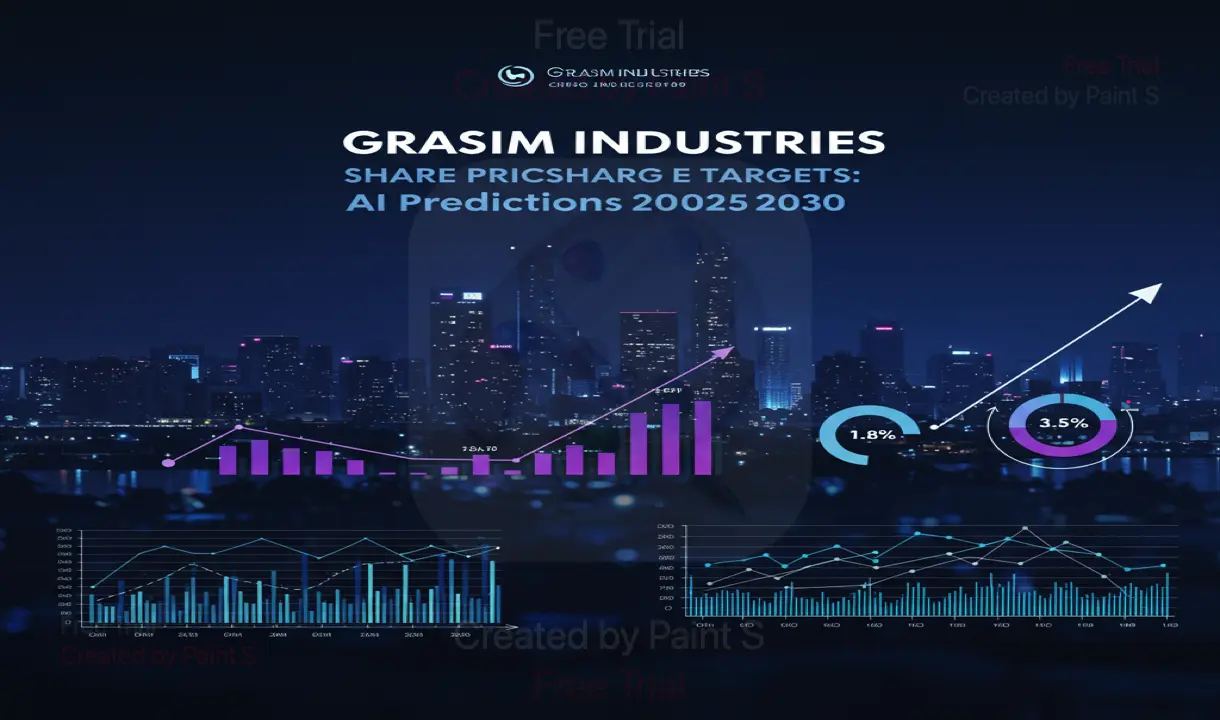Investing in the stock market can be confusing, especially when trying to guess future prices. But thanks to Artificial Intelligence (AI), investors now have smarter ways to predict trends. In this blog, we will explain simple AI-based predictions for Grasim Industries’ share price from 2025 to 2030.
What is Grasim Industries?
Grasim Industries, part of the Aditya Birla Group, is one of India’s largest Group or Corporation. It operates in sectors like cement, textiles, chemicals, and financial services. Known for its strong market presence and innovation, Grasim is a favorite among long-term investors.
Why Use AI for Stock Predictions?
AI uses machine learning algorithms to analyze vast amounts of data—past stock prices, market trends, economic indicators, and even global events. Unlike humans, AI doesn’t get emotional; it spots patterns and predicts future movements with higher accuracy. While no tool is 100% perfect, AI offers a data-backed glimpse into potential outcomes.
Grasim Share Price Predictions: 2025 to 2030

Here’s a breakdown of AI’s forecasts for Grasim Industries’ stock price, based on current trends and growth strategies:
1. 2025: Steady Growth Phase
- Target Range: ₹2,300 to ₹2,800 per share
- Why? Grasim’s expansion in cement and sustainable textiles, along with India’s infrastructure boom, could drive steady growth.
2. 2026: Green Energy Push
- Target Range: ₹2,600 to ₹3,000 per share
- Why? Increased focus on eco-friendly products (like green cement) and government policies favoring sustainability may boost investor confidence.
3. 2027: Global Expansion
- Target Range: ₹3,200 to ₹3,600 per share
- Why? Grasim’s plans to enter global markets, especially in Southeast Asia and Africa, could open new revenue streams.
4. 2028: Tech-Driven Efficiency
- Target Range: ₹3,800 to ₹4,200 per share
- Why? Adoption of AI and automation in manufacturing might cut costs and improve profit margins.
5. 2029: Economic Resilience
- Target Range: ₹4,400 to ₹4,800 per share
- Why? A stable Indian economy and Grasim’s diversified portfolio could help it weather market volatility.
6. 2030: Long-Term Vision Pays Off
- Target Range: ₹5,000+ per share
- Why? By 2030, Grasim’s investments in innovation, sustainability, and global markets may position it as a market leader, attracting institutional investors.
How Does AI Make These Predictions?
AI models consider factors like Historical stock performance, Company financials (profits, debt, revenue growth), Industry trends (demand for cement, textiles, etc.), Macroeconomic factors (GDP growth, inflation, interest rates), Global events (trade policies, climate regulations)
Key Takeaways for Investors
- Diversification is Key: Grasim’s presence in multiple sectors reduces risk.
- Sustainability Matters: Green initiatives could drive future growth.
- Think Long-Term: AI predicts gradual growth, not overnight success.
Comprission with Nifty50 Top stocks
1. Reliance Industries vs Grasim Industries
Reliance: As India’s largest conglomerate, AI predictions suggest steady growth driven by its energy, telecom, and retail businesses. Read more here
Grasim: A growing leader in cement, textiles, and chemicals; share price may rise steadily with expanding demand in infrastructure. Result: Reliance may show higher overall growth due to its diverse business portfolio.
2. Tata Consultancy Services (TCS) vs Grasim Industries
TCS: Expected to maintain strong growth in IT services with global demand for digital transformation.
Grasim: Growth driven by India’s manufacturing and real estate demand. Result: TCS may outperform Grasim due to stable IT contracts and low operational risks.
3. HDFC Bank vs Grasim Industries
HDFC Bank: Continued growth expected from strong loan demand and digital adoption.
Grasim: Steady but cyclical growth depending on cement and textile market demand. Result: HDFC Bank might offer more consistent returns, while Grasim could benefit from infrastructure expansion.
4. ICICI Bank vs Grasim Industries
ICICI Bank: Strong fundamentals with AI predicting growth due to digital and corporate loan expansion.
Grasim: More cyclical in nature, with expansion plans that may boost share price by 2030. Conclusion ICICI Bank’s steady financial growth may provide a more stable option.
5. Infosys vs Grasim Industries
Infosys: AI predicts steady demand in IT outsourcing and digital services.
Grasim: Potential rise due to demand for chemicals and cement in construction. Result Infosys may offer better consistency, but Grasim could shine with infrastructure growth.
6. Bharti Airtel vs Grasim Industries
Bharti Airtel: Growth expected with increased mobile users and 5G adoption. Grasim: Cement demand in rural and urban areas may push long-term growth. Result: Bharti Airtel might outperform Grasim in technology-driven growth markets.
7. Hindustan Unilever vs Grasim Industries
Hindustan Unilever: Stable growth with AI predicting rising demand for consumer goods.
Grasim: Growth depends on cyclical markets like cement and textile industries. Result: Hindustan Unilever may have lower volatility compared to Grasim.
8. Adani Enterprises vs Grasim Industries
Adani Enterprises: AI predictions show aggressive growth due to its infrastructure and green energy ventures.
Grasim: Moderate growth linked to infrastructure and manufacturing demand. Result, Adani Enterprises may offer higher growth but comes with higher risks.
9. Kotak Mahindra Bank vs Grasim Industries
Kotak Mahindra Bank: AI suggests steady growth with strong retail loan demand. While Grasim Long-term expansion in chemical and cement businesses. Result: Kotak Mahindra Bank may provide stable and reliable returns compared to Grasim’s cyclical growth.
10. Larsen & Toubro (L&T) vs Grasim Industries
L&T: AI predictions show strong growth driven by infrastructure projects and manufacturing demand. while, Grasim Expected growth in cement and textile sectors, benefiting from India’s infrastructure boom. Result, Both are likely to benefit from India’s infrastructure development; however, L&T may see faster returns.
#Final Thoughts
Grasim Industries shows potential for steady growth from 2025 to 2030 due to its presence in key sectors like cement, chemicals, and textiles. However, top Nifty 50 stocks like Reliance, TCS, and ICICI Bank might offer better stability or faster growth.
While AI offers exciting insights, remember that stock markets are unpredictable. External shocks (like geopolitical issues or pandemics) can disrupt even the best forecasts. Use AI predictions as a guide, not a guarantee.
If you’re eyeing Grasim Industries for your portfolio, stay updated on its quarterly results, sustainability reports, and global expansion plans. And as always, consult a financial advisor before making big decisions.
(Disclaimer: This article is for informational purposes only. Past performance and AI predictions do not guarantee future results.)






Insightful post! While on the topic, Sprunki Game is redefining music creation.